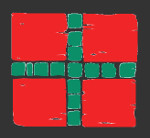Once you have flipped a mosaic, you remove the model and the mesh if you used one and see your work for the first time. Covered with dried up glue...
That pesky white glue is covering most of your tesserae in a varnish-like translucent coat.
 |
| Blue Carole, just flipped. |
The glue needs to go !
Easier said than done...
Over the years I've slaved over the damn glue ! I've tried many ways, spent many many hours in the shower, scrubbing with various metallic and plastic brushes and scouring pads. Which actually works well, but it could take me up to 5 hours to properly clean one piece, that is lots of time to spend in a shower !
I once even tried to use a different kind of glue. One that the Romans were using: a flour based glue. I thought that glue might be easier than the synthetic water soluble one I had been so far using.
And yes, flour glue is very easy to eliminate. It dissolves beautifully in water. Unfortunately, it is also edible and I paid dearly for this...
As I had one night just completed my Miriam mosaic.
I found it ravaged the next morning... A hungry rodent had liked the taste of my glue... (The little bastard soon died on my studio's floor where I found him. He did not digest well the shards of glass ingested with the glue)
I repaired the damages and stayed away from edible glues afterwards...
Having reverted to my White Elmer's Glue, I tried various chemicals. Vinegar, Hypochloric acid, Caustic Soda (NaOH), Drano, and possibly a few more I do not remember. In a few cases I created colorful fumes and almost choked to death. The shower still remained my best and safest option...
Then I had one of my brilliant ideas and purchased a pressure washer. Used at the right angle, this thing did wonders, allowing me to clean a 16 Square foot piece in 1 1/2 hour.
The pressure washer is basically fantastic with 3/4" or bigger tesserae.
But if you work with smaller tesserae the water jet easily lifts some of them and sends them flying all over the place, and the time spent in repairs may offset the time saved by using the pressure washer.
For my 3/16" tesserae, I decided last fall to try hot water. I boiled a big pot of water, poured some on my mosaic and scrubbed with steel wool. The glue went away nice and clean ! It worked beautifully, and this is now how I clean up my pieces.
I have one other mode of operation I'd like to try one day, but for the time being I am very satisfied with my hot water...

Frederic Lecut is a French mosaicist.
In 1992 he made Alabama his home.
His Art is about inspiring People.
You can contact him either
by phone at (334) 798 1639 or email at
You can also subscribe to his



